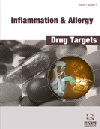- Home
- A-Z Publications
- Inflammation & Allergy-Drug Targets (Discontinued)
- Previous Issues
- Volume 10, Issue 2, 2011
Inflammation & Allergy-Drug Targets (Discontinued) - Volume 10, Issue 2, 2011
Volume 10, Issue 2, 2011
-
-
Editorial [Hot Topic: Hydrogen Sulfide: From Molecular Biology to Pharmacology Guest Editor: Stefano Fiorucci)]
More LessSmall molecules gaseous neuro-transmitters are a family of biologically relevant mediators that orchestrate the activity of a myriad of biologically essential functions in mammals [1-4]. After the discovery of nitric oxide (NO), awarded by the Nobel prize in 1998, at least two other gaseous mediators have been added to this family, i.e. carbon monoxide (CO) and hydrogen sulfide (H2S). These agents are increasingly investig Read More
-
-
-
Hydrogen Sulfide: From Physiology to Pharmacology
More LessGaseous neurotransmitters are a growing family of enzimatically generated gaseous mediators that exert regulatory functions in mammals. It is now widely recognized that hydrogen sulfide (H2S), along with nitric oxide (NO) and carbon monoxide (CO), is an important signaling molecule in cardiovascular, nervous, gastrointestinal, liver and lung physiology and pharmacology. The production of H2S from L-cysteine is catalyse Read More
-
-
-
Hydrogen Sulfide Generation in Mammals: The Molecular Biology of Cystathionine-β-Synthase (CBS) and Cystathionine-γ-Lyase (CSE)
More LessCystathionine-β-synthase (CBS) and cystathionine-γ-lyase (CSE) are two key enzymes involved in the synthesis of hydrogen sulfide (H2S). CBS catalyzes the pyridoxal 5'-phosphate (PLP)-dependent conversion of homocysteine in cystathionine whilst CSE the pyridoxal 5'-phosphate (PLP)-dependent synthesis of L-cysteine from cystathionine. In mammals, CBS gene transcription is poorly investigated and the activity of the Read More
-
-
-
Hydrogen Sulfide in Gastrointestinal and Liver Physiopathology
More LessAuthors: Sabrina Cipriani and Andrea MencarelliHydrogen sulfide (H2S) is a gas that can be formed by the action of two enzymes, cystathionine gamma lyase (CSE) and cystathionine beta synthase (CBS). H2S has been known for hundreds of years for its poisoning effect, however the idea that H2S is not only a poison, but can exert a physiological role in mammalian organisms, originates from the evidence that this gaseous mediator is produced endogenously. In additi Read More
-
-
-
Hydrogen Sulphide in Heart and Systemic Circulation
More LessAuthors: Mariarosaria Bucci and Giuseppe CirinoIn the mammalian cardiovascular system, H2S joins carbon monoxide (CO) and endothelial derived relaxing factors, (EDRFs)-nitric oxide (NO), as the third gasotransmitter. In the vasculature, cystathionine-γ-lyase (CSE) is the main enzyme responsible for H2S biosynthesis starting from the substrate e.g. L-cysteine. There is a growing body of evidence that supports a role for H2S in regulating the vascular homeostasis. H2S ( Read More
-
-
-
The Neurophysiology of Hydrogen Sulfide
More LessAuthors: Weifang Rong, Hideo Kimura and David GrundyHydrogen sulfide (H2S) has emerged as the third endogenous gaseous mediator in the central and peripheral nervous system. H2S is generated by three enzymes, cystathionine-β-synthase (CBS), cystathionine-γ-lyase (CSE) and 3- mercaptopyruvate sulfurtransferase (3MST). In the CNS, H2S, generated mainly by CBS in astrocytes and 3MST in neurons, appears to participate in cognition, memory, regulation of the cardiopulmo Read More
-
-
-
Hydrogen Sulfide in Inflammation: Friend or Foe?
More LessAuthors: Akhil Hegde and Madhav BhatiaHydrogen sulfide (H2S), the gaseous mediator produced by various cells in our body, was recently discovered to play a major role in human physiology despite its toxic nature known for centuries. In addition to its pathophysiological relevance in cardiovascular and neuronal disorders, there is considerable interest in the significance of H2S in inflammation. A number of preclinical studies in our laboratory as well as by ot Read More
-
-
-
Hydrogen Sulphide and Pain
More LessPhysiopathological mechanisms and treatment of pain remain a significant challenge. In the last decade, the gasotransmitter hydrogen sulphide (H2S) has received wide attention for its ability to act as a multilevel regulatory molecule in a variety of biologic functions in mammals including modulation of pain processing. Results from preclinical models of pain, including experimentally-induced somatic, neurophatic and visce Read More
-
-
-
Hydrogen Sulfide-Based Therapies: Focus on H2S Releasing NSAIDs
More LessAuthors: Stefano Fiorucci and Luca SantucciNonsteroidal anti-inflammatory pain medications, commonly referred to as NSAIDs, are effective treatment for pain, fever and inflammation. However their use associates with a 4-6 fold increase in the risk of gastrointestinal bleeding. The basic mode of action of NSAIDs lies in the inhibition of cyclooxygenases (COXs), a family of enzymes involved in the generation of prostaglandins (PGs). The COX exists at least in t Read More
-
-
-
The Implication of Pseudomonas aeruginosa Biofilms in Infections
More LessBiofilm formation by bacteria is recognized as a major problem in chronic infections due to their recalcitrance against the immune defense and available antibiotic treatment schemes. The opportunistic pathogen Pseudomonas aeruginosa has drawn special attention in this regard due to its severity of infection in the lungs of cystic fibrosis patients and in chronic wounds. In this review we address the molecular basis of biofil Read More
-
Most Read This Month
Article
content/journals/iadt
Journal
10
5
false
en


